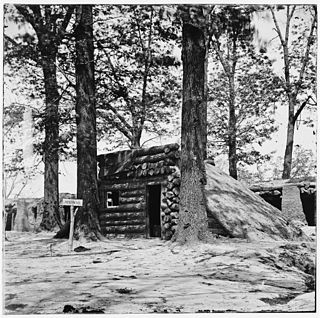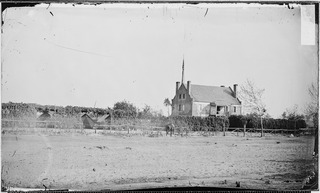 W
WThe Richmond–Petersburg campaign was a series of battles around Petersburg, Virginia, fought from June 15, 1864, to April 2, 1865, during the American Civil War. Although it is more popularly known as the siege of Petersburg, it was not a classic military siege, in which a city is usually surrounded and all supply lines are cut off, nor was it strictly limited to actions against Petersburg. The campaign consisted of nine months of trench warfare in which Union forces commanded by Lt. Gen. Ulysses S. Grant assaulted Petersburg unsuccessfully and then constructed trench lines that eventually extended over 30 miles (48 km) from the eastern outskirts of Richmond, Virginia, to around the eastern and southern outskirts of Petersburg. Petersburg was crucial to the supply of Confederate Gen. Robert E. Lee's army and the Confederate capital of Richmond. Numerous raids were conducted and battles fought in attempts to cut off the Richmond and Petersburg Railroad. Many of these battles caused the lengthening of the trench lines.
 W
WThe Beefsteak Raid was a Confederate cavalry raid that took place in September 1864 as part of the Siege of Petersburg during the American Civil War. Confederate Maj. Gen. Wade Hampton led a force of 3,000 troopers of the Confederate States Army on what was to become a 100-mile (160 km) ride to acquire cattle that were intended for consumption by the Union Army, which was laying a combined siege to the cities of Richmond and Petersburg, Virginia.
 W
WThe Battle of the Boydton Plank Road, fought on October 27–28, 1864, followed the successful Battle of Peebles's Farm in the siege of Petersburg during the American Civil War. It was an attempt by the Union Army to seize the Boydton and Petersburg Plank Road and cut the South Side Railroad, a critical supply line to Petersburg, Virginia.
 W
WThe Battle of Chaffin's Farm and New Market Heights, also known as Laurel Hill and combats at Forts Harrison, Johnson, and Gilmer, was fought in Virginia on September 29–30, 1864, as part of the siege of Petersburg in the American Civil War.
 W
WThe Battle of the Crater was a battle of the American Civil War, part of the siege of Petersburg. It took place on Saturday, July 30, 1864, between the Confederate Army of Northern Virginia, commanded by General Robert E. Lee, and the Union Army of the Potomac, commanded by Major General George G. Meade.
 W
WThe Battle of Darbytown and New Market Roads was an engagement between Union and Confederate forces during the American Civil War, which took place on October 7, 1864, in Henrico County, Virginia, as part of the Richmond-Petersburg Campaign.
 W
WThe Battle of Darbytown Road was fought on October 13, 1864, between Union and Confederate forces. The Confederates were attempting to retake ground they had lost to Federal forces during battles near Richmond, Virginia. Their efforts failed. On October 13, Union forces advanced to find and feel the new Confederate defensive line in front of Richmond. While mostly a battle of skirmishers, a Federal brigade assaulted fortifications north of Darbytown Road and was repulsed with heavy casualties. The Federals retired to their entrenched lines along New Market Road.
 W
WThe First Battle of Deep Bottom, also known as Darbytown, Strawberry Plains, New Market Road, or Gravel Hill, was fought July 27–29, 1864, at Deep Bottom in Henrico County, Virginia, as part of the Siege of Petersburg of the American Civil War. A Union force under Maj. Gens. Winfield S. Hancock and Philip H. Sheridan was sent on an expedition threatening Richmond, Virginia, and its railroads, intending to attract Confederate troops away from the Petersburg defensive line, in anticipation of the upcoming Battle of the Crater. The Union infantry and cavalry force was unable to break through the Confederate fortifications at Bailey's Creek and Fussell's Mill and was withdrawn, but it achieved its desired effect of momentarily reducing Confederate strength at Petersburg.
 W
WDutch Gap Canal is located on the James River in Chesterfield County, Virginia just north of the lost 17th-century town of Henricus. The canal's construction was initiated by Union forces during the American Civil War to bypass a meander loop of the river around a peninsula known as Farrar's Island that was controlled by Confederate artillery. The canal was completed after the war and is now the main channel of the James River in this area. Today, the area south of the canal is the location of the Dutch Gap Conservation Area and Henricus Historical Park.
 W
WThe Battle of Fort Stedman, also known as the Battle of Hare's Hill, was fought on March 25, 1865, during the final weeks of the American Civil War. The Union Army fortification in the siege lines around Petersburg, Virginia, was attacked in a pre-dawn Confederate assault by troops led by Maj. Gen. John B. Gordon. The attack was the last serious attempt by Confederate troops to break the Siege of Petersburg. After an initial success, Gordon's men were driven back by Union troops of the IX Corps commanded by Maj. Gen. John G. Parke.
 W
WThe Battle of Globe Tavern, also known as the Second Battle of the Weldon Railroad, fought August 18–21, 1864, south of Petersburg, Virginia, was the second attempt of the Union Army to sever the Weldon Railroad during the siege of Petersburg of the American Civil War. A Union force under Maj. Gen. Gouverneur K. Warren destroyed miles of track and withstood strong attacks from Confederate troops under Gen. P.G.T. Beauregard and Lt. Gen. A.P. Hill. It was the first Union victory in the Richmond–Petersburg Campaign. It forced the Confederates to carry their supplies 30 miles (48 km) by wagon to bypass the new Union lines that were extended farther to the south and west.
 W
WThe Battle of Hatcher's Run, also known as Dabney's Mill, Armstrong's Mill, Rowanty Creek, and Vaughn Road, fought February 5–7, 1865, was one in a series of Union offensives during the siege of Petersburg, aimed at cutting off Confederate supply traffic on Boydton Plank Road and the Weldon Railroad west of Petersburg, Virginia.
 W
WThe Battle of Kabletown was a battle between Confederate and Union forces near the end of the American Civil War. Captain John S. Mosby, with nine companies of cavalry, defeated Captain Richard R. Blazer's outnumbered Blazer's Scouts.
 W
WThe Battle of Peebles's Farm was the western part of a simultaneous Union offensive against the Confederate works guarding Petersburg and Richmond, Virginia, during the Siege of Petersburg in the American Civil War.
 W
WThe Battle of Petersburg was an unsuccessful Union assault against the earthworks fortification, the Dimmock Line, protecting the city of Petersburg, Virginia, June 9, 1864, during the American Civil War. Because of the ragtag group of defenders involved, it is sometimes known as the Battle of Old Men and Young Boys.
 W
WThe Second Battle of Petersburg, also known as the Assault on Petersburg, was fought June 15–18, 1864, at the beginning of the Richmond–Petersburg Campaign. Union forces under Lt. Gen. Ulysses S. Grant and Major General George G. Meade attempted to capture Petersburg, Virginia, before Gen. Robert E. Lee's Confederate Army of Northern Virginia could reinforce the city.
 W
WThe First Battle of Ream's Station was fought on June 29, 1864, during the Wilson-Kautz Raid of the American Civil War. Confederate forces under Maj. Gen. William Mahone and Brig. Gen. Fitzhugh Lee defeated Union cavalry raiding Confederate railroads south of Petersburg, Virginia.
 W
WThe Second Battle of Ream's Station was fought during the siege of Petersburg in the American Civil War on August 25, 1864, in Dinwiddie County, Virginia. A Union force under Maj. Gen. Winfield S. Hancock began destroying part of the Petersburg Railroad, which was a vital supply line for Gen. Robert E. Lee's Confederate army in Petersburg, Virginia. Lee sent a force under Lt. Gen. A. P. Hill to challenge Hancock and the Confederates were able to rout the Union troops from their fortifications at Reams Station. However, they lost a key portion of the railroad, causing further logistical difficulties for the remainder of the Richmond-Petersburg Campaign.
 W
WThe Battle of Sappony Church, also known as the Battle of Stony Creek Depot, was an engagement of the American Civil War, between the Confederate States of America and the Union, which took place on June 28, 1864, during the Wilson-Kautz Raid of the Richmond–Petersburg Campaign.
 W
WThe Battle of Staunton River Bridge was an engagement on June 25, 1864, between Union and Confederate forces during Wilson-Kautz Raid of the American Civil War. The battle took place around the Staunton River Bridge, over the Staunton River, in Halifax and Charlotte counties, Virginia.
 W
WThe Battle of Trent's Reach was one of the final major naval battles of the American Civil War. Beginning on January 23, 1865, a powerful flotilla of Confederate warships bombarded Fort Brady along the James River and engaged four Union Navy ships with the intention of breaking through the blockade to attack City Point, the base of General Ulysses S. Grant who was besieging Petersburg, Virginia. After two days of fighting, the rebels withdrew back up the river without completing their objectives.
 W
WThe Wilson–Kautz Raid was a cavalry operation in south central Virginia in late June 1864, during the American Civil War. Occurring early in the Richmond-Petersburg Campaign, the raid was conducted by Union cavalry under Brigadier Generals James H. Wilson and August Kautz, who were ordered to cut railroads between Lynchburg, Virginia, and the vital Confederate rail supply center at Petersburg. While the raid had the intended effect of disrupting Confederate rail communications for several weeks, the raiding force lost much of its artillery, all of its supply train, and almost a third of the original force, mostly to Confederate capture.